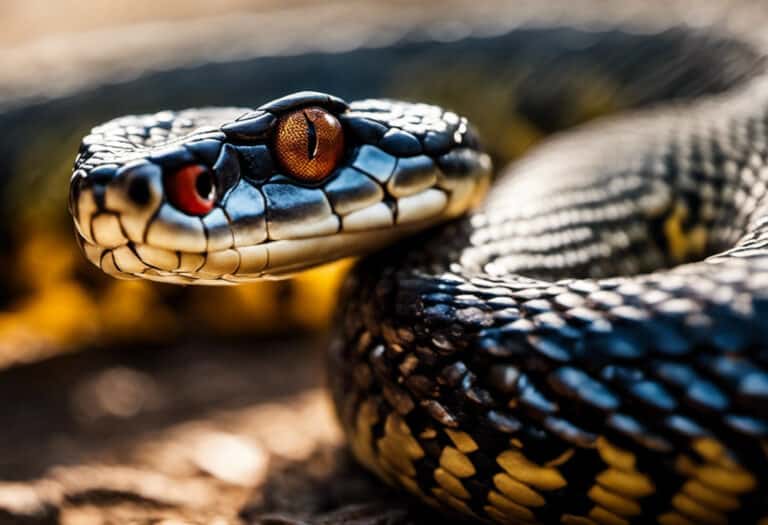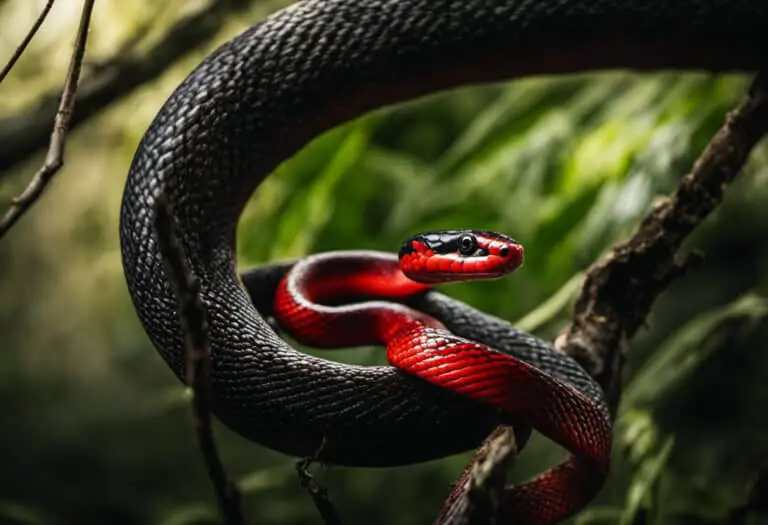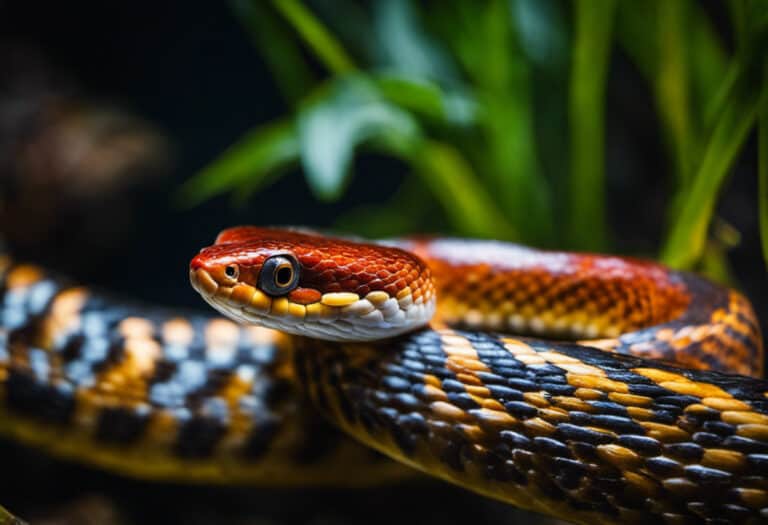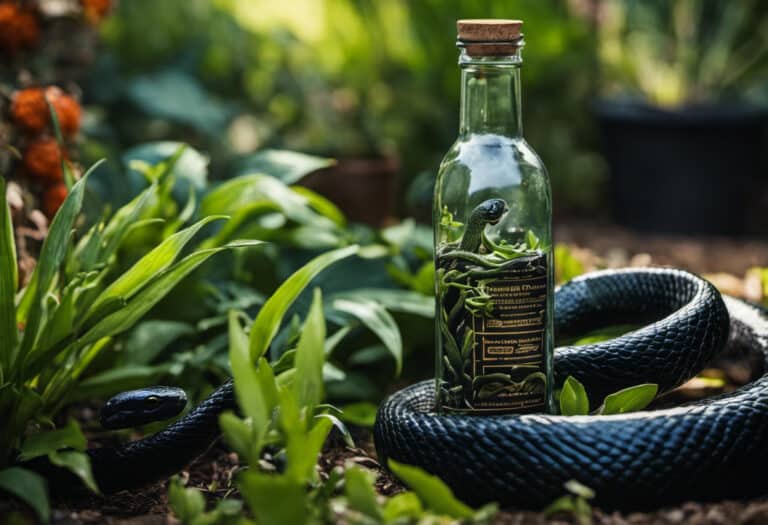Are Eastern Hognose Snakes Venomous?
So, you’re curious about Eastern Hognose Snakes, huh? Well, get ready to uncover the truth about these intriguing creatures.
Eastern Hognose Snakes, with their vibrant colors and distinctive hissing sound, have captured the attention of many. But what about their venomous nature? Are they a threat?
In this article, we’ll break it down for you, providing all the scientific details you need to make an informed decision.
So sit back, relax, and let’s dive into the world of Eastern Hognose Snakes.
Key Takeaways
- Eastern Hognose snakes are not venomous and are harmless to humans.
- They have unique defense mechanisms such as hissing, striking as a bluff, and playing dead.
- Their preferred habitat includes sandy soils near open woodlands or forest edges.
- Conservation efforts are being made to ensure their long-term survival and understanding their population trends is crucial for management.
Physical Characteristics of Eastern Hognose Snakes
Eastern hognose snakes have a heavy body and their color can range from yellow, gray, brown, olive, to black.
They exhibit unique physical characteristics that make them easily identifiable. Some individuals have a slate gray color with dark blotches behind the eyes, while others have dark brown blotches on their back.
These snakes are known for their ability to produce a loud hissing sound when threatened. In terms of habitat preferences, Eastern hognose snakes are typically found in sandy soils near open woodlands or forest edges. They’ve adapted well to these environments and are able to thrive in the eastern third of Minnesota.
It’s important to note that these harmless snakes are often mistaken as venomous, leading to unnecessary harm to the population.
Reproduction and Life Cycle of Eastern Hognose Snakes
During the spring, you can expect female hognose snakes to lay 15 to 25 eggs in depressions under rocks, logs, or sandy soil. This is a crucial part of their reproductive process.
The Eastern hognose snake mating behavior is fascinating to observe. Once they find a mate, the female will carefully select a suitable location to lay her eggs. She’ll create a cozy nest by digging a depression in the ground or finding a hidden spot under rocks or logs. This ensures protection and warmth for the developing eggs.
The Eastern hognose snake egg laying process typically occurs in June or July. After a couple of months, around August or September, the eggs will hatch, giving life to a new generation of these amazing snakes. It’s truly remarkable how nature works its magic.
Dietary Habits of Eastern Hognose Snakes
Eastern hognose snakes have specific dietary habits that revolve around their primary food source, which is toads. These snakes possess large teeth in the back of their mouths, allowing them to puncture inflated toads for easier swallowing.
However, they aren’t limited to toads and also consume frogs, salamanders, and small mammals as part of their varied diet.
Toads: Primary Food Source
Toads are the primary food source for hognose snakes, and they’ve large teeth in the back of their mouths to puncture inflated toads for easier swallowing. This puncture technique allows them to consume their prey more efficiently.
While toads make up the majority of their diet, hognose snakes also have alternative prey options. They’ll feed on frogs, salamanders, and small mammals when available. However, toads remain their preferred choice due to their abundance and nutritional value.
The hognose snake’s ability to puncture and swallow inflated toads demonstrates their specialized adaptations for survival. This unique feeding behavior showcases the snake’s evolutionary success in utilizing a specific food source.
Understanding the hognose snake’s dietary habits and feeding techniques provides insight into their ecological role as a predator and their importance in maintaining a balanced ecosystem.
Puncturing Inflated Toads
The unique ability of hognose snakes to puncture and swallow inflated toads showcases their specialized adaptations for survival, allowing them to efficiently consume their preferred prey.
When faced with an inflated toad, the hognose snake utilizes its large teeth located in the back of its mouth to puncture the toad’s skin. This allows the snake to deflate the toad, making it easier to swallow.
This feeding behavior is crucial for the hognose snake’s survival, as toads are their primary food source. By possessing the ability to puncture and consume inflated toads, hognose snakes have evolved a highly efficient feeding strategy. This specialization enables them to maximize their energy intake and thrive in their natural habitat.
Their unique feeding behavior is a testament to their remarkable adaptations and their ability to adapt to the challenges of their environment.
Other Prey Options
If you encounter a hognose snake, it may surprise you to learn that they also feed on a variety of other prey such as frogs, salamanders, and small mammals. Eastern hognose snakes have often been misunderstood and mistaken as venomous, but in reality, they’re harmless. Here are some facts about their other prey options and the misconceptions about their venomous nature:
-
Frogs: Hognose snakes primarily feed on toads, but they also consume frogs. Their large teeth in the back of their mouth allow them to puncture inflated toads for easier swallowing.
-
Salamanders: These snakes have been observed preying on salamanders, taking advantage of their slow movements and easy capture.
-
Small mammals: In addition to amphibians, hognose snakes have been known to eat small mammals like mice and voles. They use their powerful jaws to subdue their prey.
-
Misconceptions: Due to their defensive behavior, which includes hissing loudly and striking as a bluff, hognose snakes are often mistaken as venomous. However, they’re harmless and pose no threat to humans.
Natural Predators of Eastern Hognose Snakes
Hawks and various mammals are the predators that pose a threat to eastern hognose snakes. These snakes have a variety of camouflage techniques to help them blend into their surroundings and avoid detection by predators.
Their coloration can range from yellow, gray, brown, olive, to black, allowing them to blend in with different habitats. Some have slate gray color with dark blotches behind the eyes, while others have dark brown blotches on their backs.
When threatened, eastern hognose snakes will hiss loudly and strike repeatedly as a bluff. However, if the predator doesn’t retreat, they may resort to a dramatic behavior – rolling over on their backs and playing dead. This unique defense mechanism often confuses predators and gives the snake a chance to escape.
Habitat and Distribution of Eastern Hognose Snakes
You can find eastern hognose snakes in sandy soils near open woodlands or forest edges. They’ve specific habitat preferences and a limited geographical range.
Here are some key facts about their habitat and distribution:
Habitat Preferences:
- Eastern hognose snakes prefer sandy soils, which provide them with easy burrowing opportunities.
- They’re often found near open woodlands or forest edges, where they can find their preferred prey and shelter.
Geographical Range:
- Eastern hognose snakes are mainly found in the eastern third of Minnesota, although their range extends to other parts of the United States and Canada.
- They’re also found in areas with similar sandy soil habitats, such as the Great Lakes region and the Northeastern United States.
Understanding the habitat preferences and geographical range of eastern hognose snakes is crucial for their conservation and management. By protecting their preferred habitats and ensuring their presence in these areas, we can contribute to the preservation of these fascinating and important snake species.
Population Status and Conservation of Eastern Hognose Snakes
The population of eastern hognose snakes in Minnesota appears to be stable, but there are no official counts conducted to determine their exact numbers.
However, conservation efforts are being made to ensure the long-term survival of these fascinating snakes. Eastern hognose snake population trends are closely monitored by local organizations and herpetologists to better understand their distribution and habitat preferences.
To engage the audience, let’s take a look at a table highlighting some interesting facts about eastern hognose snakes:
| Facts about Eastern Hognose Snakes |
|---|
| Eastern hognose snakes are heavy-bodied. |
| Their color ranges from yellow to black. |
| They produce a loud hissing sound. |
| Their primary food source is toads. |
These captivating creatures play a crucial role in the ecosystem as both predator and prey.
Conservation efforts aim to protect their habitats and raise awareness about their importance. By understanding the population trends of eastern hognose snakes, we can work towards their long-term conservation and ensure their freedom to thrive in their natural environment.
Misconceptions About Eastern Hognose Snakes
Let’s debunk some common misconceptions about Eastern Hognose Snakes, as they’ve often been misunderstood in popular culture.
-
Eastern Hognose Snakes are venomous: This is a widespread misconception. In reality, these snakes are harmless to humans. They possess rear fangs and mildly toxic saliva, but their venom isn’t potent enough to harm humans.
-
They are aggressive: Contrary to popular belief, Eastern Hognose Snakes aren’t aggressive creatures. When threatened, they may hiss, flatten their heads, and even strike as a bluff, but they rarely bite. Their defensive behaviors are mainly intended to scare away potential predators.
-
They can inflate their bodies: Although it might seem like Eastern Hognose Snakes can inflate their bodies like balloons, this isn’t true. They’ve the ability to puff up their necks and flatten their heads to appear larger, but they can’t physically inflate themselves.
-
They are dangerous to pets: Another misconception is that Eastern Hognose Snakes pose a threat to pets. In reality, they prefer to avoid confrontation and will likely retreat or play dead if approached by a pet. Pet owners need not worry about their furry friends encountering these harmless snakes.
It’s important to dispel these misconceptions and learn the truth about Eastern Hognose Snakes. By understanding their behavior and characteristics, we can coexist peacefully with these fascinating creatures.
Defensive Behaviors of Eastern Hognose Snakes
When threatened, Eastern hognose snakes display a range of defensive behaviors to protect themselves.
First, they flatten their heads and necks, making themselves appear larger and more intimidating to potential predators.
In addition, they emit a loud hissing sound and strike repeatedly, using these actions as a bluff to scare away their assailant.
If these tactics fail, the hognose snake may resort to a unique behavior – it will roll over onto its back and play dead, hoping that the predator will lose interest and leave it alone.
Flattening and Hissing
Flattening their heads and necks, eastern hognose snakes hiss loudly to intimidate predators. This behavior is part of their defense mechanism, designed to appear larger and more threatening.
Here is a list of some key behaviors and defense mechanisms exhibited by eastern hognose snakes:
-
Head and Neck Flattening: When feeling threatened, these snakes will flatten their heads and necks, giving themselves a more intimidating appearance.
-
Loud Hissing: Eastern hognose snakes are known for their distinctive hissing sound, which serves as a warning to potential predators.
-
Bluff Strikes: In addition to hissing, these snakes may also strike repeatedly as a bluff, aiming to scare off their foes.
-
Playing Dead: If the predator doesn’t retreat, the hognose snake may resort to a dramatic tactic, rolling over on its back and playing dead.
These behaviors and defense mechanisms effectively deter many predators, ensuring the freedom and safety of the eastern hognose snake.
Striking as a Bluff
You may be surprised to learn that striking repeatedly is actually a bluff used by hognose snakes to scare away potential predators. These snakes have a unique defensive behavior that involves hissing loudly, flattening their heads and necks, and striking with their mouths closed.
This striking behavior is purely a show, as hognose snakes aren’t venomous and their strikes are harmless. By mimicking the aggressive behavior of venomous snakes, hognose snakes effectively deter predators who may be wary of getting bitten.
This predator avoidance strategy is just one of the many fascinating behaviors exhibited by these remarkable reptiles. Understanding the defensive behaviors of hognose snakes not only enhances our knowledge of their biology but also highlights the incredible adaptability and survival strategies that exist in the natural world.
Playing Dead Tactic
Now let’s explore the fascinating playing dead behavior of the eastern hognose snake. This tactic is a powerful defense mechanism that the snake employs when faced with a threat.
Here’s why the playing dead tactic is so effective:
-
Convincing performance: When the hognose snake feels threatened, it puts on an Oscar-worthy performance. It flips onto its back, opens its mouth wide, and hangs its tongue out, appearing lifeless and completely vulnerable. This dramatic display often convinces predators that the snake is already dead, discouraging further aggression.
-
Enhanced survival: By playing dead, the hognose snake increases its chances of survival. Predators may lose interest and move on, allowing the snake to escape unharmed. This tactic also minimizes the risk of injury that could occur during a physical confrontation.
-
Psychological advantage: By utilizing the playing dead behavior, the hognose snake gains a psychological advantage over its predators. It exploits their instinctual aversion to consuming dead animals, making itself an unappetizing choice.
-
Camouflage effectiveness: The hognose snake’s ability to play dead is supported by its natural camouflage. Its coloration and patterns help it blend into its environment, further enhancing the illusion of death.
The playing dead tactic is undoubtedly an effective and clever defense strategy employed by the eastern hognose snake. By mastering this behavior, the snake can survive and thrive in its natural habitat, ensuring its freedom and continued existence.
Interesting Facts About Eastern Hognose Snakes
Did you know that when eastern hognose snakes feel threatened, they’ve a unique defense mechanism where they play dead by rolling over on their backs? This tactic is just one of the many interesting adaptations of these fascinating snakes.
Eastern hognose snakes are known for their ability to adapt to different environments and communicate through various methods.
One of their adaptations is their heavy-bodied structure, which allows them to blend into their surroundings and hide from predators. They also have the ability to change their color, ranging from yellow to black, helping them camouflage even better.
Eastern hognose snakes communicate through a variety of methods, including hissing loudly when they feel threatened and striking repeatedly as a bluff. They also possess large teeth in the back of their mouths, which they use to puncture inflated toads for easier swallowing.
Understanding the Venomous Nature of Eastern Hognose Snakes
Be cautious when encountering these snakes, as their unique defense mechanisms can sometimes be mistaken for venomous behavior. Eastern hognose snakes are often misunderstood due to misconceptions about their venomous nature. Here are some key points to help you understand them better:
-
Identification: Eastern hognose snakes are heavy-bodied and can vary in color from yellow, gray, brown, olive, to black. Some have slate gray color with dark blotches behind the eyes, while others have dark brown blotches on the back. They also produce a loud hissing sound.
-
Reproduction: Mating occurs in the spring, and females lay 15 to 25 eggs in depressions under rocks, logs, or sandy soil. The eggs are deposited in June or July and hatch in August and September.
-
Food: The primary food source for eastern hognose snakes is toads, but they also feed on frogs, salamanders, and small mammals. They possess large teeth in the back of their mouth to puncture inflated toads for easier swallowing.
-
Predators: Predators of eastern hognose snakes include hawks and various mammals.
It is important to dispel the misconception that eastern hognose snakes are venomous. These harmless snakes play a vital role in the ecosystem and should be appreciated for their unique behaviors and defense mechanisms.
Frequently Asked Questions
How Do Eastern Hognose Snakes Defend Themselves From Predators?
Eastern hognose snakes defend themselves from predators using various strategies. They coil, flatten their heads and necks, hiss loudly, and strike as a bluff. If the predator persists, they may roll over and play dead.
What Is the Primary Food Source of Eastern Hognose Snakes?
Eastern hognose snakes primarily feed on toads, using their large teeth to puncture inflated toads for easier swallowing. They are found in sandy soils near open woodlands or forest edges, which are their preferred habitats.
Do Eastern Hognose Snakes Lay Eggs or Give Live Birth?
Eastern hognose snakes lay eggs as part of their reproductive behavior. Mating rituals occur in the spring, and females deposit 15 to 25 eggs in depressions under rocks, logs, or sandy soil.
Where Are Eastern Hognose Snakes Commonly Found in Minnesota?
Eastern hognose snakes are commonly found in sandy soils near open woodlands or forest edges in Minnesota. They have a unique behavior where they flatten their heads and necks, hiss loudly, and even play dead when threatened.
Are Eastern Hognose Snakes Venomous?
Eastern Hognose Snakes are not venomous. They primarily feed on toads and have large teeth to puncture them for easier swallowing. Their harmless nature is often misunderstood, leading to unnecessary killings.
Conclusion
After delving into the physical characteristics, reproductive habits, diet, predators, habitat, and distribution of Eastern Hognose Snakes, it’s clear that they aren’t venomous. Despite conflicting opinions, scientific evidence debunks the theory of their venomous nature.
These fascinating creatures play an important role in their ecosystems and deserve our understanding and protection. So, the next time you encounter an Eastern Hognose Snake, rest assured that it poses no venomous threat and appreciate its unique qualities.






